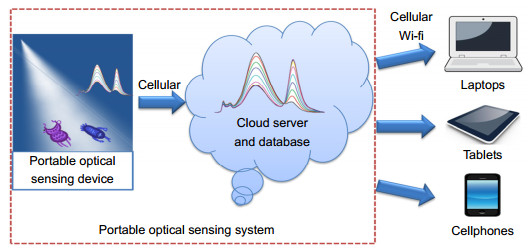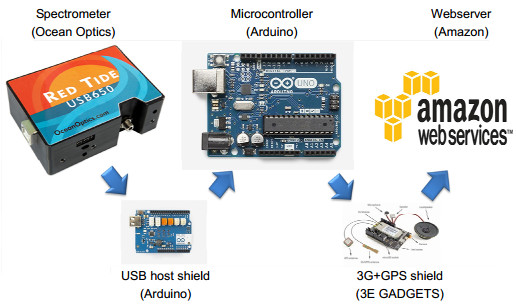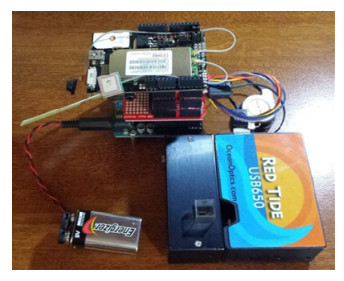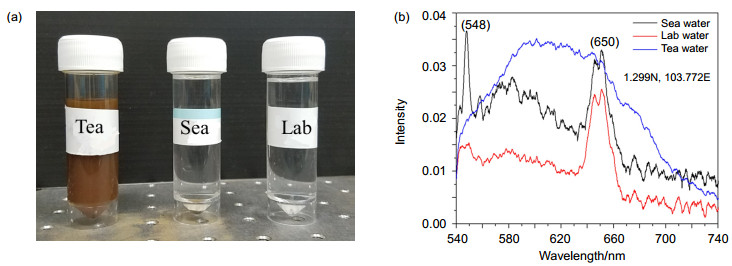-
Abstract
Development of a prototype of a portable optical sensing system is presented for fast detecting of samples' fluorescence spectra. A compact configuration is achieved by integrating a small spectrometer, a microcontroller, a Universal Serial Bus (USB) Host Shield, a network module, and a web server. The fluorescence spectra of a tested sample can be obtained. Then the test data are sent through network communication to our Cloud Server which can store the data for further analyses. With this configuration, test results can be revealed in a short time and downloaded by users to their laptops, tablets or cellphones anytime and anywhere.

-
Key words:
- optical sensing /
- real-time detection /
- fluorescence spectra
-
Overview

Abstract: Fluorescence has a wide variety of applications, including gemology, mineralogy, medicine, chemical sensing, printing dye, and biological labellings. Detection methods based on spectral analysis techniques are an interesting alternative for performing sensitive, selective and reliable measurements. The application of fluorescence in spectral analysis techniques is fluorescence spectrometry which has been successfully utilized as a basic measurement method to obtain the characterization of chemical constituents for food classification, water pollution, bacterial pathogens detection and plant species characterization with minimal sample preparation and relatively low-cost instrumentation. Much effort has been done to improve the performance of the fluorescence spectral analysis devices to increase the precision and speed. Although various methods have been explored to improve the instruments' design and manufacture, the portability remains a huge challenge.
This paper provides the details regarding the fundamental of a portable optical sensing system to fast detect the fluorescence spectra of the samples. A compact configuration is achieved by integrating a small spectrometer as an optical sensor, a microcontroller for issuing commands, a USB Host Shield for internal communication, a network module for external communication, and a web server for storing database and distributing results. The system can offer real-time detection capability, and the test results can be revealed in a short time and downloaded by users to their laptops, tablets or cellphones anytime and anywhere.
The main components of the system include a spectrometer (Ocean Optics), a Microcontroller Board (Arduino), a USB Host Shield (Arduino), a 3G+GPS Shield (3E Gadgets) and a Webserver (Amazon). In working condition, the Arduino microcontroller first initializes the USB650 Spectrometer, through the Arduino USB Host shield. Then it sends commands to the spectrometer to acquire spectra of the sample taken. Through the GPS system, the microcontroller acquires the location of the sample and capture an image of the collected sample using Hayes command sets (AT command). Next, together with the spectra data, the microcontroller sends this information up to the web server through the 3G network using 3G + GPS shield for Arduino. In the final step, the web server categories them and processes the spectra data by linking it to the database. The analyzed results are returned to the web server for users to view from any mobile devices that have web browsers, by logging into the web server.
In the experiment, three water samples were analyzed, firstly tea water, secondly sea water from West Coast Park of Singapore, and thirdly laboratory tap water. It is concluded that the tea water emits the strongest fluorescence, followed by sea water, while laboratory tap water has no fluorescence emitted. The fluorescence spectra of three water samples have been detected using our system within a short time, thus validating the system's effectiveness.
-

-
参考文献
[1] Albani J R. Principles and applications of fluorescence spec-troscopy[M]. Oxford Ames, Iowa: John Wiley & Sons, 2007.
[2] Guilbault G G. Practical fluorescence[M]. New York: CRC Press, 1990.
[3] Eaton-Magaña S, Post J E, Heaney P J, et al. Fluorescence spectra of colored diamonds using a rapid, mobile spectrometer [J]. Gems & Gemology, 2007, 43(4): 332-351.
[4] Marsala A F, Loermans T, Shen S, et al. Portable energy-dis-persive X-ray fluorescence integrates mineralogy and chemostratigraphy into real-time formation evaluation[J]. Petrophysics, 2012, 53(2): 102-109. http://www.onepetro.org/journal-paper/spwla-2012-v53n2a3
[5] Yukawa H, Baba Y. In vivo fluorescence imaging and the diagnosis of stem cells using quantum dots for regenerative medicine[J]. Analytical Chemistry, 2017, 89(5): 2671-2681. doi: 10.1021/acs.analchem.6b04763
[6] Elgemeie G H, Ahmed K A, Ahmed E A, et al. A simple approach for the synthesis of coumarin fluorescent dyes under microwave irradiation and their application in textile printing[J]. Pigment & Resin Technology, 2016, 45(4): 217-224. https://www.deepdyve.com/lp/emerald-publishing/a-simple-approach-for-the-synthesis-of-coumarin-fluorescent-dyes-under-KeCDKTOUle
[7] Lenhardt L, Bro R, Zekovi ć I, et al. Fluorescence spectroscopy coupled with PARAFAC and PLS DA for characterization and classification of honey[J]. Food Chemistry, 2015, 175: 284-291. doi: 10.1016/j.foodchem.2014.11.162
[8] Karoui R, Blecker C. Fluorescence spectroscopy measurement for quality assessment of food systems-a review[J]. Food and Bioprocess Technology, 2011, 4(3): 364-386. doi: 10.1007/s11947-010-0370-0
[9] Huang C J, Dostalek J, Sessitsch A, et al. Long-range surface plasmon-enhanced fluorescence spectroscopy biosensor for ultrasensitive detection of E. coli O157: H7[J]. Analytical Chemistry, 2011, 83(3): 674-677. doi: 10.1021/ac102773r
[10] Yang Jian, Shi Shuo, Gong Wei, et al. The characterization of plant species using first-derivative fluorescence spectra[J]. Luminescence, 2017, 32(3): 348-352. doi: 10.1002/bio.v32.3
[11] Lin L, Dikeman R, Molini B, et al. Photochemical treatment of platelet concentrates with amotosalen and long-wavelength ultraviolet light inactivates a broad spectrum of pathogenic bacteria[J]. Transfusion, 2004, 44(10): 1496-1504. doi: 10.1111/trf.2004.44.issue-10
[12] Wachsmuth M, Conrad C, Bulkescher J, et al. High-throughput fluorescence correlation spectroscopy enables analysis of proteome dynamics in living cells[J]. Nature Biotechnology, 2015, 33(4): 384-389. doi: 10.1038/nbt.3146
[13] Butte P, Lapchak P, Kittle D S. Time-resolved laser-induced fluorescence spectroscopy systems and uses thereof: U. S. Patent, 20160377547[P]. 2016-12-29.
[14] USB-650 red tide spectrometers[EB/OL]. https://oceanoptics.com/product/usb-650-red-tide-spectrometers/.
[15] Arduino & Genuino UNO[EB/OL]. https://www.arduino.cc/en/Main/ArduinoBoardUno/.
-
访问统计


 E-mail Alert
E-mail Alert RSS
RSS

 下载:
下载:







